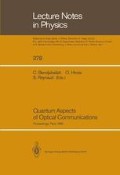Abstract
The optical communication theory has been developed in the fields of both mathematics and engineering, and it has become very important recently. In this paper we mathematically treat quantum control communication processes from information theoretical points of view, and we derive error probabilities for a concrete quantum channel in each digital modulation and detection. In paticular, several error probabilities for a coherent state and a squeezed state are rigorously calculated. It is shown that a proper squeezed state provides us a lower error probability, namely, better efficiency for optical communication.
Preview
Unable to display preview. Download preview PDF.
References
M. Ohya: “On compound state and mutual information in quantum information theory”, IEEE.Trans.Inf.Theory, 29, pp.770–774 (1983).
M. Ohya: “Some aspects of quantum information theory and their applications to irreversible processes”, Rep. on Math. Phys., 27, pp.19–47 (1989).
C.W. Helstrom: “Quantum detection and estimation theory”, Academic Press (1976).
D. Stoler: “Equivalence class of minimum uncertainty packets”, Phys. Rev., D1, pp.3217–3219 (1970) and D4, pp.1925–1926 (1971).
J.N. Hollenhorst: “Quantum limits on resonant-mass gravitational-radiation detectors”, Phys. Rev. D19, pp.1669–1679 (1979).
H.P. Yuen: “Two-photon coherent states of the radiation field”, Phys. Rev., A13, pp.2226–2243 (1976).
H.P. Yuen and J.H. Shapiro: “Optical communication with two-photon coherent states-Part III: Quantum measurements realizable with photoemissi detectors”, IEEE.Trans.Inf.Theory, IT-26, No.1, pp.78–92 (1980).
M. Ohya, H. Yoshimi and O. Hirota: “Rigorous derivation of error probability in quantum control communication processes”, IEICE of Japan, J71-B, No.4, 533–539 (1988).
C.E. Shannon: “A mathematical theory of communication”, Bell System Tech.J., 27, pp.379–423,623–656 (1948).
L. Accardi and M. Ohya: “Compoud channels, transition expectations and liftings”, preprint.
E.B. Davies: “Quantum theory of open systems”, Academic Press (1976).
R.J. Glauber: “Coherent and incoherent states of the radiation field”, Phys. Rev. 131, pp.2766–2788 (1963).
M. Ohya and H. Suyari: in preparation.
M. Ohya and H. Suyari: “Optimization of error probability in quantum control communication processes”, IEICE of Japan, J73-B-I, No.3, 200–207 (1990).
Author information
Authors and Affiliations
Editor information
Rights and permissions
Copyright information
© 1991 Springer-Verlag
About this paper
Cite this paper
Ohya, M., Suyari, H. (1991). Rigorous derivation of error probability in coherent optical communication. In: Bendjaballah, C., Hirota, O., Reynaud, S. (eds) Quantum Aspects of Optical Communications. Lecture Notes in Physics, vol 378. Springer, Berlin, Heidelberg. https://doi.org/10.1007/3-540-53862-3_180
Download citation
DOI: https://doi.org/10.1007/3-540-53862-3_180
Published:
Publisher Name: Springer, Berlin, Heidelberg
Print ISBN: 978-3-540-53862-2
Online ISBN: 978-3-540-46366-5
eBook Packages: Springer Book Archive

